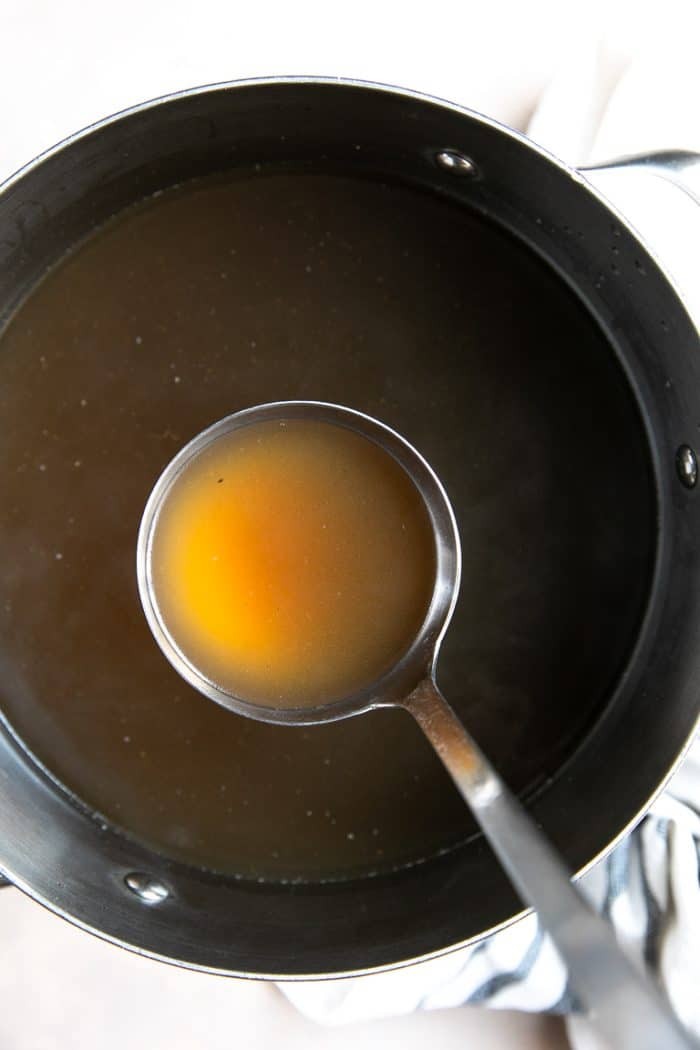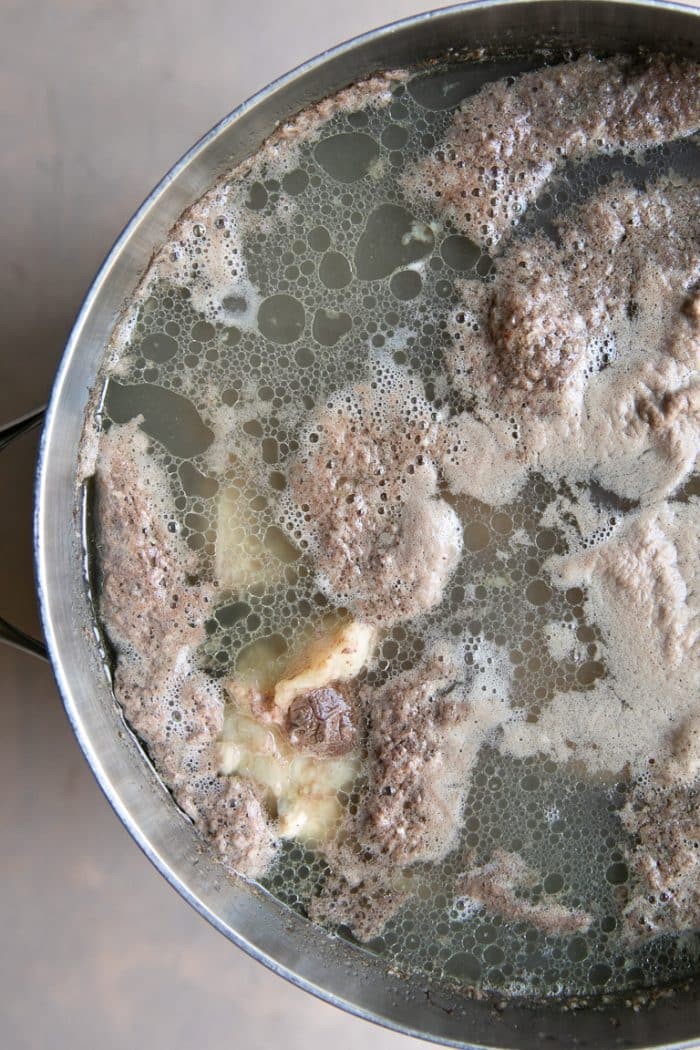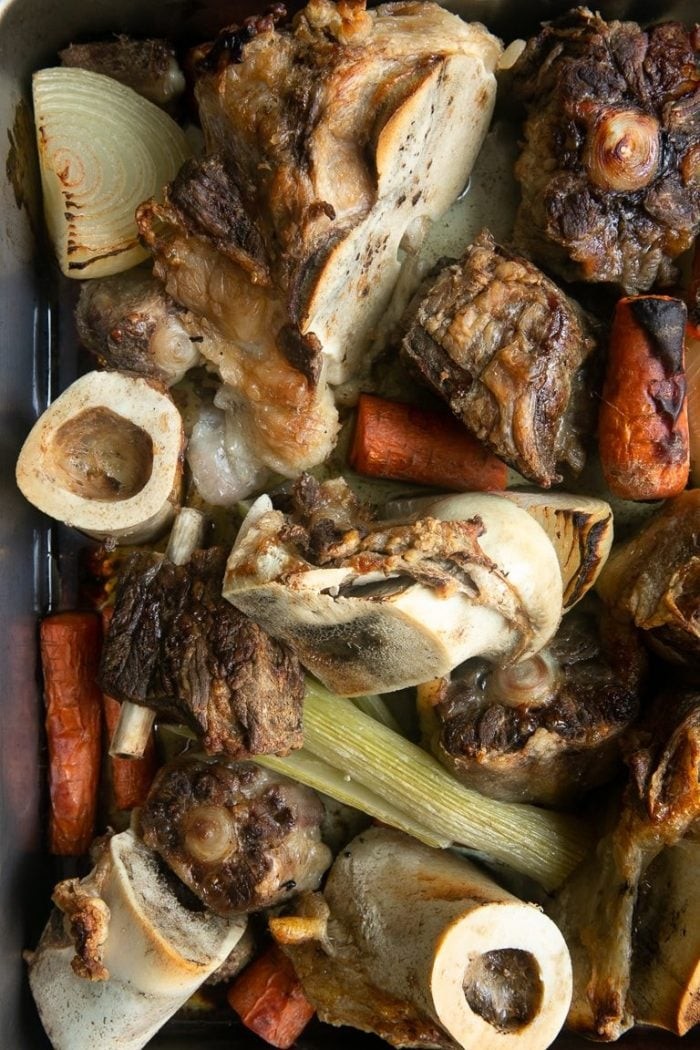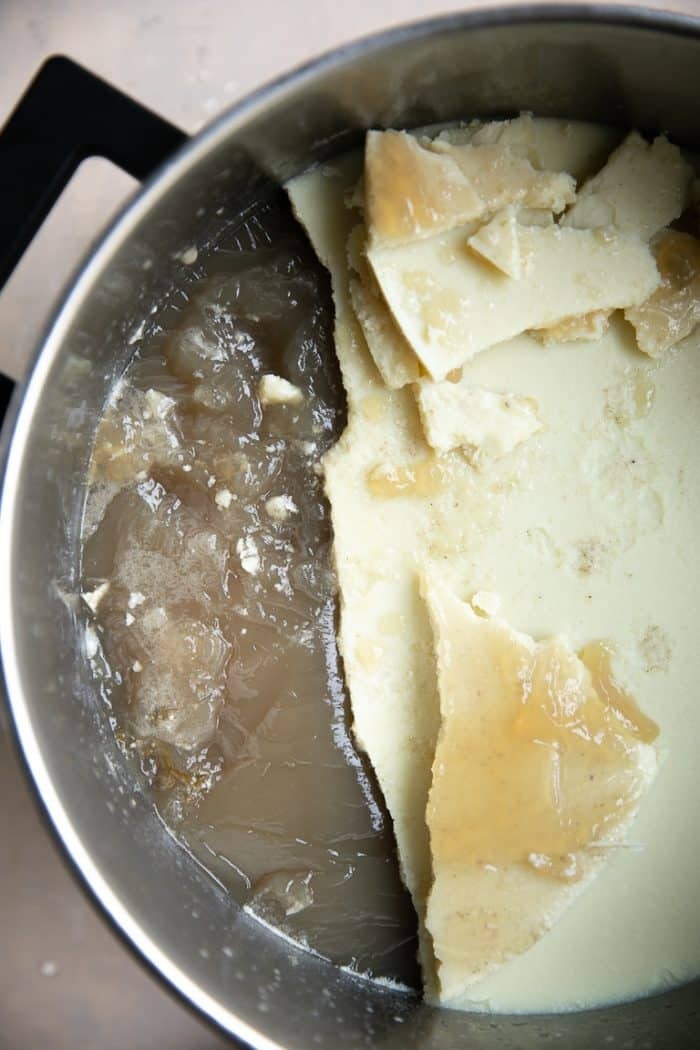Making bone broth at home is easier than you think, and HOW.EDU.VN is here to guide you through every step of the process, unlocking a world of potential health benefits with this age-old elixir. From sourcing the best bones to simmering techniques, discover how to create a flavorful and collagen-rich bone broth that supports your joints, gut health, and overall well-being. Embrace the goodness of homemade bone broth and elevate your culinary and wellness journey with us today; explore expert tips for crafting the perfect sipping broth, beef broth, and chicken broth.
1. What is Bone Broth and Why Should You Make It?
Bone broth is a nutrient-dense liquid made by simmering animal bones, connective tissues, and often vegetables, herbs, and spices in water for an extended period. It differs from regular broth or stock due to its longer simmering time and the use of bones rich in collagen, resulting in a gelatinous texture when cooled. Let’s delve into what makes bone broth special.
1.1. Bone Broth vs. Regular Broth and Stock: Key Differences
While the terms are often used interchangeably, there are distinct differences:
- Bone Broth: Simmered for extended periods (12+ hours), resulting in a collagen-rich broth that gels when cooled.
- Stock: Typically made from bones and simmered for a shorter duration than bone broth.
- Broth: Made from meat rather than bones, resulting in a thinner consistency with less collagen.
1.2. Unveiling the Potential Health Benefits of Bone Broth
Bone broth has gained popularity due to its purported health benefits, including:
- Nutrient-Rich: Contains vitamins, minerals, and amino acids.
- Joint Support: Glucosamine and chondroitin may reduce osteoarthritis symptoms.
- Digestive Health: Amino acids may aid in managing inflammatory bowel disease.
- Sleep Improvement: Glycine, an amino acid in bone broth, may improve sleep quality.
- Weight Management: High protein content may promote satiety.
- Inflammation Reduction: Amino acids like glycine and arginine have anti-inflammatory effects.
It’s worth noting that while these benefits are promising, more research is needed to confirm them definitively.
2. Gathering Your Ingredients and Equipment
To make bone broth at home, you’ll need:
2.1. The Essential Ingredients for Bone Broth
- Bones: Beef, chicken, turkey, or pork bones (a mix of marrow bones, knuckle bones, and meaty bones is ideal).
- Vegetables: Carrots, onions, celery, garlic.
- Herbs & Spices: Bay leaves, peppercorns, star anise, cinnamon sticks.
- Acid: Apple cider vinegar or white vinegar (to help break down the bones).
- Water: Filtered water is recommended.
2.2. Essential Equipment for Making Bone Broth
- Large Stockpot or Instant Pot: A large stockpot (8 quarts or larger) is suitable for stovetop simmering. An Instant Pot or pressure cooker can significantly reduce cooking time.
- Roasting Pan: For roasting the bones and vegetables to enhance flavor.
- Fine-Mesh Strainer: To strain the broth and remove solids.
- Cheesecloth (optional): For an extra clear broth.
- Storage Containers: Jars or freezer-safe containers for storing the finished broth.
2.3. Selecting the Best Bones for a Flavorful Broth
The type of bones you use significantly impacts the flavor and nutrient content of your bone broth. Here’s a guide:
| Bone Type | Benefits | Uses |
|---|---|---|
| Marrow Bones | Rich in marrow, which adds flavor and nutrients. | Femur bones are a good source. Ask your butcher to cut them in half. |
| Knuckle Bones | High in collagen and connective tissue, contributing to a gelatinous texture. | Great for beef and chicken bone broth. |
| Meaty Bones | Adds depth of flavor. | Oxtail, short ribs, and shank are excellent choices for beef broth. |
| Chicken Feet | Inexpensive and high in gelatin. | Ideal for chicken bone broth. |




3. Step-by-Step Guide to Making Bone Broth
Now that you have your ingredients and equipment, let’s get started.
3.1. Step 1: Blanching the Bones (Optional but Recommended)
- Place the bones in a large pot and cover with cold water.
- Bring to a boil and simmer for 10-15 minutes.
- Drain the bones and rinse them thoroughly with water.
Blanching helps remove impurities and results in a cleaner-tasting broth.
3.2. Step 2: Roasting the Bones and Vegetables
- Preheat your oven to 450°F (232°C).
- Place the blanched bones and chopped vegetables (carrots, onions, celery, garlic) in a roasting pan.
- Roast for 30 minutes, then toss and roast for another 15-30 minutes, until the bones and vegetables are browned.
Roasting enhances the flavor of the broth by caramelizing the bones and vegetables.
3.3. Step 3: Simmering on the Stovetop or Using an Instant Pot
Stovetop Method:
- Transfer the roasted bones and vegetables to a large stockpot.
- Add bay leaves, peppercorns, star anise, cinnamon sticks, and apple cider vinegar.
- Cover the bones and vegetables with cold water (about 12 cups).
- Bring to a low boil, then reduce heat to low and simmer for 8-24 hours, skimming off any foam or excess fat.
Instant Pot Method:
- Place the roasted bones and vegetables in the Instant Pot.
- Add bay leaves, peppercorns, star anise, cinnamon sticks, and apple cider vinegar.
- Cover the bones and vegetables with cold water.
- Seal the Instant Pot and cook on high pressure for 2-4 hours, followed by a natural pressure release.
3.4. Step 4: Straining and Storing Your Bone Broth
- Strain the broth through a fine-mesh strainer to remove solids.
- For an extra clear broth, strain again through cheesecloth.
- Allow the broth to cool slightly, then store in jars or freezer-safe containers.
- Refrigerate for up to 5 days or freeze for up to 6 months.
3.5. Maximizing Flavor: Tips and Tricks for the Best Bone Broth
- Use a variety of bones: Different bones contribute different flavors and nutrients.
- Don’t skip the roasting: Roasting the bones and vegetables adds depth of flavor.
- Simmer for a long time: The longer the simmer, the more collagen is extracted.
- Skim the impurities: Skimming off any foam or excess fat during simmering results in a cleaner broth.
- Season to taste: Add salt and other seasonings to enhance the flavor.
4. How to Use Bone Broth in Your Daily Life
4.1. Sipping Bone Broth for Health and Wellness
Many people enjoy sipping warm bone broth as a nourishing and restorative beverage. You can add a sprinkle of sea salt, cracked pepper, or a squeeze of lemon juice for added flavor. Aim for 2-4 cups daily as part of a balanced diet.
4.2. Culinary Applications: Cooking with Bone Broth
Bone broth can be used in place of regular broth or stock in various recipes, including:
- Soups and stews
- Sauces and gravies
- Risotto
- Grain dishes (quinoa, rice)
- Braising liquids
4.3. Freezing and Storing Bone Broth for Later Use
Bone broth freezes exceptionally well. Store it in freezer-safe containers or bags for up to 6 months. When freezing in glass jars, leave some headspace to allow for expansion.
5. Addressing Common Questions About Bone Broth
5.1. Is Bone Broth Suitable for Everyone?
Bone broth is generally safe for most people. However, it may not be suitable for:
- Vegetarians and vegans: Bone broth is made from animal bones.
- People with histamine intolerance: Bone broth can be high in histamine.
- People following a low-protein diet: Bone broth is a good source of protein.
5.2. Can I Make Bone Broth in a Slow Cooker?
Yes, you can make bone broth in a slow cooker. Follow the same steps as the stovetop method, but cook on low for 24-48 hours.
5.3. How Much Bone Broth Should I Drink Each Day?
For general health and wellness, aim for 2-4 cups daily. If you’re drinking bone broth for medicinal reasons, consult with your doctor.
5.4. What are the Best Bones for Collagen?
The best bones for collagen are those rich in connective tissue, such as knuckle bones, joints, and chicken feet. These bones contain a high amount of collagen that converts to gelatin when simmered, providing the broth with its characteristic jelly-like consistency and health benefits.
5.5. How Long Does Bone Broth Last in the Fridge?
Bone broth typically lasts for 4-5 days in the refrigerator. Ensure it is stored in an airtight container to maintain its freshness and prevent contamination.
5.6. Can Bone Broth Help with Gut Health?
Yes, bone broth can help with gut health. It contains amino acids like glutamine, which can help reduce inflammation in the gut and improve the integrity of the intestinal lining. This can be particularly beneficial for people with leaky gut syndrome or inflammatory bowel diseases.
5.7. Is it Better to Roast Bones Before Making Bone Broth?
Yes, it is generally better to roast bones before making bone broth. Roasting the bones enhances their flavor by caramelizing them, which adds depth and richness to the broth. It also helps to draw out more nutrients from the bones.
5.8. Can I Add Vegetables to Bone Broth?
Absolutely you can add vegetables to bone broth. Vegetables such as carrots, onions, and celery not only enhance the flavor but also add additional nutrients to the broth.
5.9. How Do I Skim the Fat from Bone Broth?
To skim the fat from bone broth, refrigerate the broth overnight. The fat will solidify on top, making it easy to remove with a spoon.
5.10. What is the Difference Between Bone Broth and Chicken Stock?
The main difference between bone broth and chicken stock lies in the cooking time and the part of the animal used. Bone broth is simmered for a longer duration (often 12-24 hours) to extract maximum nutrients from the bones and connective tissues, while chicken stock is typically simmered for a shorter period and may include more meat.
6. The Expertise You Need, Right at Your Fingertips
Navigating the world of health and wellness can be overwhelming. At HOW.EDU.VN, we connect you with leading experts, including over 100 renowned PhDs, who can provide personalized guidance on nutrition, health, and more.
6.1. Connect with Experts for Personalized Guidance
Our team of experts can help you:
- Develop a personalized nutrition plan that incorporates bone broth and other nutrient-rich foods.
- Address specific health concerns and find evidence-based solutions.
- Stay informed about the latest research and trends in health and wellness.
6.2. Why Choose HOW.EDU.VN for Expert Advice?
- Access to Top Experts: Our network includes PhDs and specialists from various fields.
- Personalized Consultations: Receive tailored advice to meet your unique needs.
- Reliable Information: Benefit from evidence-based guidance you can trust.
- Convenient Online Platform: Connect with experts from anywhere in the world.
6.3. Case Studies: How Expert Consultations Can Transform Lives
Consider Sarah, a 45-year-old woman struggling with joint pain. After consulting with a nutritionist through HOW.EDU.VN, she learned about the benefits of bone broth and incorporated it into her diet. Within a few weeks, she noticed a significant reduction in her pain and improved mobility.
Or John, a 32-year-old man with digestive issues. A consultation with a gastroenterologist on our platform helped him identify the underlying causes of his symptoms and develop a gut-healing protocol that included bone broth.
7. Take the Next Step Towards a Healthier You
Making bone broth at home is a simple yet powerful way to nourish your body and support your well-being. With the right ingredients, equipment, and guidance, you can create a delicious and nutrient-rich elixir that benefits your joints, gut health, and overall vitality.
7.1. Ready to Experience the Benefits of Expert Guidance?
Don’t let unanswered questions or persistent challenges hold you back. At HOW.EDU.VN, we’re dedicated to providing you with the expert support you need to thrive.
7.2. Contact Us Today for Personalized Solutions
Visit HOW.EDU.VN today and explore the possibilities. Whether you’re seeking advice on nutrition, health, or any other area of expertise, our team of PhDs is here to guide you every step of the way.
Address: 456 Expertise Plaza, Consult City, CA 90210, United States
WhatsApp: +1 (310) 555-1212
Website: HOW.EDU.VN
8. FAQs About Making and Using Bone Broth
8.1. What Types of Bones are Best for Bone Broth?
A mix of marrow bones, knuckle bones, and meaty bones is ideal.
8.2. Do I Need to Blanch the Bones?
Blanching is optional but recommended for a cleaner-tasting broth.
8.3. How Long Should I Simmer Bone Broth?
Simmer for at least 8 hours, ideally 12-24 hours.
8.4. Can I Make Bone Broth in an Instant Pot?
Yes, cook on high pressure for 2-4 hours, followed by a natural pressure release.
8.5. How Do I Store Bone Broth?
Refrigerate for up to 5 days or freeze for up to 6 months.
8.6. How Much Bone Broth Should I Drink Each Day?
Aim for 2-4 cups daily as part of a balanced diet.
8.7. Is Bone Broth Suitable for Everyone?
Not suitable for vegetarians, vegans, or people with histamine intolerance.
8.8. What are the Benefits of Drinking Bone Broth?
Potential benefits include nutrient richness, joint support, digestive health, sleep improvement, weight management, and inflammation reduction.
8.9. Can I Use Bone Broth in Cooking?
Yes, use it in place of regular broth or stock in soups, stews, sauces, and more.
8.10. Where Can I Find High-Quality Bones for Bone Broth?
Ask your local butcher for grass-fed, organic bones.
9. Unlock Your Potential with Expert Guidance from HOW.EDU.VN
Don’t navigate the complexities of health and wellness alone. Let the experts at HOW.EDU.VN empower you with personalized guidance and evidence-based solutions. Contact us today and embark on your journey towards a healthier, happier you. With how.edu.vn, access a wealth of knowledge and support, ensuring you receive the best possible advice tailored to your unique needs, from bone broth recipes to comprehensive wellness strategies.